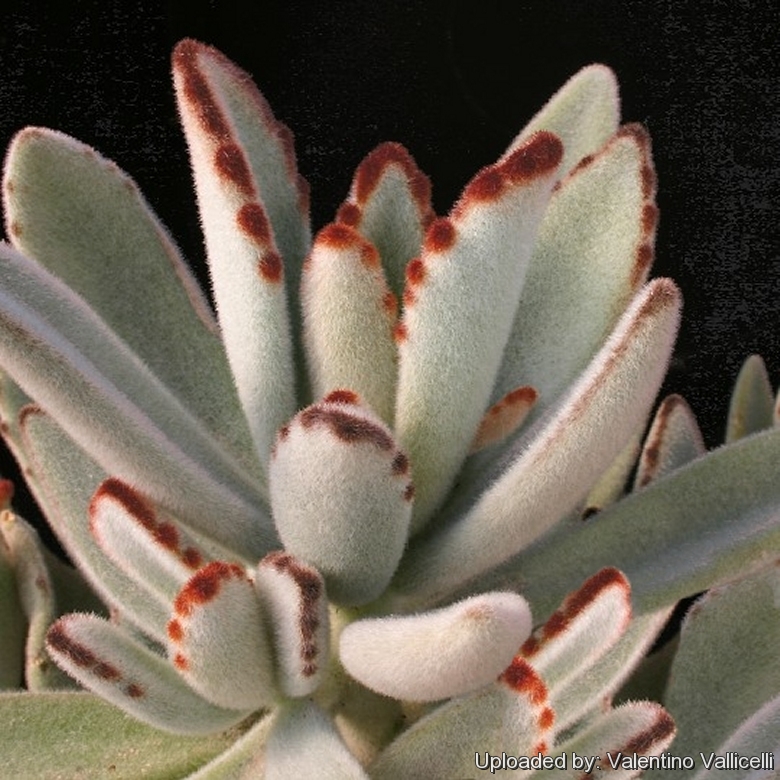
Kalanchoe tomentosa Photo by: Valentino Vallicelli
Origin and Habitat: Endemic to Madagascar.
Habitat: It is found on granite rocks.
Ecology: The dense covering of hairs performs a vital function for the plant in the form of water conservation. In the dry environment in which it lives, it must conserve what little water it can absorb from the soil. The dense mat of hairs growing from the leaf retards the movement of air directly across the leaf surface, thereby reducing water vapor loss (transpiration). The “dead-air” space created by the numerous trichomes insulates the leaf from its harsh external environment, too. In addition, the white-silver appearance of the leaves reflects light, lessening the chances of the leaves overheating.
Synonyms:
See all synonyms of Kalanchoe tomentosa
back
Accepted name in llifle Database:Kalanchoe tomentosa BakerJ. Bot. 20: 110 1882
Cultivars
(1):
back
Common Names include:
ENGLISH: Panda Plant, Panda-bear Plant, kalanchoe, Cocoon Plant, Velvet Leaf Kalanchoe, Pussy Ears, Plush Plant, White Lady
LITHUANIAN (Lietuvių): Pūkuotoji kalankė
RUSSIAN (Русский): Каланxое войлочное
Description: It is a beautiful slow growing perennial succulent plant with dense white felt-like hairs covering the entire leaf eventually forming an upright small shrub that will reach about 35-45 cm (In nature, it grows to 1 m in height). It is a very attractive but polymorphic species and there are many cultivars with color variants .It is commonly sold as Panda Plant or Pussy Ears because of its furry leaves.
Stems: Robust, branched at the base and densely hairy, with the base becoming woody with age.
Rosettes: At stems apexes.
Leaves: Stalkless, fleshy, narrowly oval, pointed, 5-7 cm long, thickly covered with spreading whitish to blue-green hairs (trichomes) in the center except at the tips which have several shallow notches with rich chocolate coloured hairs giving it a rather attractive look.
Flowers: In a narrow panicle about 30 cm long, with cymose branches, the upper close and many-flowered, Flowers greenish white.
Subspecies, varieties, forms and cultivars of plants belonging to the Kalanchoe tomentosa group
 Kalanchoe tomentosa Baker: Has silvery-white hairy leaves that appear grey to blue-green except at the tips which have several reddish-chocolate shallow notches .
Kalanchoe tomentosa Baker: Has silvery-white hairy leaves that appear grey to blue-green except at the tips which have several reddish-chocolate shallow notches . Kalanchoe tomentosa cv. Chocolate Soldier: Individual leaves are more red-brown all around the edges and thinner and longer than for the standard species. It also grows a bit faster with more of a clumping habit.
Kalanchoe tomentosa cv. Chocolate Soldier: Individual leaves are more red-brown all around the edges and thinner and longer than for the standard species. It also grows a bit faster with more of a clumping habit.
Bibliography: Major references and further lectures
1) Forest & Kim Starr “Kalanchoe tomentosa (Panda plant, plush plant, pussy ears)”. Plants of Hawaii. <http://www.starrenvironmental.com>. Web. 27 Sep. 2014.
2) Sajeva & Costanzo Succulents, "The Illustrated Dictionary" 1994
3) James Cullen, Sabina G. Knees, H. Suzanne Cubey “The European Garden Flora Flowering Plants:A Manual for the Identification of Plants Cultivated in Europe, Both Out-of-Doors and Under Glass” Cambridge University Press, 11/ago/2011
4) Werner Rauh “The Wonderful World of Succulents: Cultivation and Description of Selected Succulent Plants Other Than Cacti” Smithsonian Institution Press, 1984
5) Hermann Jacobsen “A handbook of succulent plants: descriptions, synonyms, and cultural details for succulents other than Cactaceae, Volume 1” Blandford Press, 1960
6) Eggli, U. "The Illustrated Handbook of Succulent Plants; Crassulaceae." Berlin: Springer-Verlag. 2003
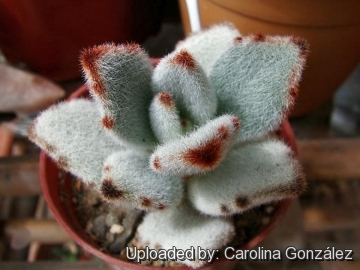 Kalanchoe tomentosa Photo by: Carolina González
Kalanchoe tomentosa Photo by: Carolina González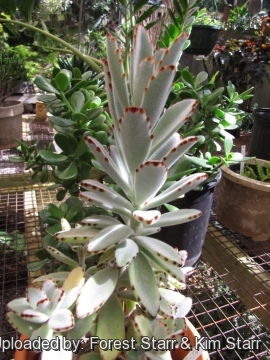 Habit at Sacred Garden of Maliko, Maui, Hawaii (USA). January 24, 2011 Photo by: Forest Starr & Kim Starr
Habit at Sacred Garden of Maliko, Maui, Hawaii (USA). January 24, 2011 Photo by: Forest Starr & Kim Starr Kalanchoe tomentosa Photo by: Giuseppe Distefano
Kalanchoe tomentosa Photo by: Giuseppe Distefano Leaves at Kula Botanical Garden, Maui, Hawaii (USA). March 07, 2011. Photo by: Forest Starr & Kim Starr
Leaves at Kula Botanical Garden, Maui, Hawaii (USA). March 07, 2011. Photo by: Forest Starr & Kim Starr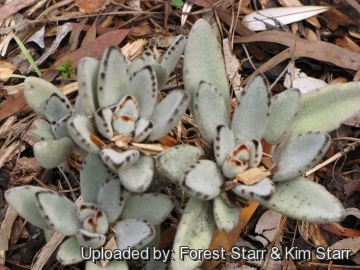 Habit at Kula Botanical Garden, Maui, Hawaii (USA). March 07, 2011. Photo by: Forest Starr & Kim Starr
Habit at Kula Botanical Garden, Maui, Hawaii (USA). March 07, 2011. Photo by: Forest Starr & Kim Starr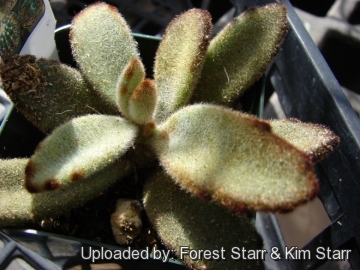 Habit at Walmart Kahului, Maui, Hawaii (USA). January 17, 2008. Photo by: Forest Starr & Kim Starr
Habit at Walmart Kahului, Maui, Hawaii (USA). January 17, 2008. Photo by: Forest Starr & Kim Starr Kalanchoe tomentosa Photo by: Cactus Art
Kalanchoe tomentosa Photo by: Cactus ArtSend a photo of this plant.The gallery now contains thousands of pictures, however it is possible to do even more. We are, of course, seeking photos of species not yet shown in the gallery but not only that, we are also looking for better pictures than those already present.
Read More... Cultivation and Propagation: Kalanchoe tomentosaSN|21226]]SN|21226]] is one of the easiest-to-grow succulents and looks wonderful mass planted in a hot spot in the garden. It needs dry conditions and is not suited to outdoor planting in high rainfall areas because in this conditions it is not such a bright, clean-looking plant as it is when grown indoors, but is very useful in containers in dry places. It makes a good house plant for heated homes. Like most succulents, this plant is tolerant of the dry atmosphere usually found in the home.
Exposition: It needs full sun to light shade, or bright indirect lighting in the home. Bright light for woolliest appearance. However, it should not be subjected to the direct sun of midday.
Soil: It need a porous soil containing about one third grit with adequate drainage.
Repotting: Repot at least every two years.
Hardiness: They need warm temperature and should be kept at a minimum of 10° C. Protect from frost. These plants come from very warm areas and may develop rot if kept too cool.
Waterings: They are drought tolerant, but came from damper climates than most succulents and like more water in the summer. Plants are watered and allow to dry thoroughly before watering again. Like most plants, it will benefit from good ventilation, but should not be exposed to prolonged draughts. During the Autumn and winter months, plants are watered only enough to keep the leaves from shrivelling. This plant will soon begin to rot if kept wet at low temperatures.
Fertilization: Fertilize only during the growing season (Spring and Summer) with a balanced cactus food or one recommended for tomatoes diluted to half the strength recommended on the label.
Pests and diseases: Kalanchoe, like most members of the Crassulaceae family, have succulent leaves which are a great attraction for pests such as Mealy Bugs. While this species is no more prone to attack than others, because of the silvery-white hairy leaves, it is easy to miss the first signs of these pests. Therefore, a regular, careful inspection is sensible. If rot affects the plant, it normally starts at the root... if spotted early, cuttings can be made easily from the tips of the stems to make new plants.
Maintenance: It branches freely to make a prostrate clump. After a while, it can become straggly and should be clipped back to keep it in check and make it neat and tidy. The trimmings make ideal cuttings.
Uses: Grow this Kalanchoe in a rock garden or on a rock wall in mild climates. In cold areas, grow this heat-loving Madagascar native indoors or plant outdoors as an annual.
Propagation: It is propagated by stem cutting or by leaf cuttings in spring or summer. Leaves removed from the plant very carefully will produce small plant in about 4 weeks. Succulent cuttings root easily in moist sandy mix or perlite. Root three or four cuttings together in a single pot to give an almost ‘instant’ plant.

















